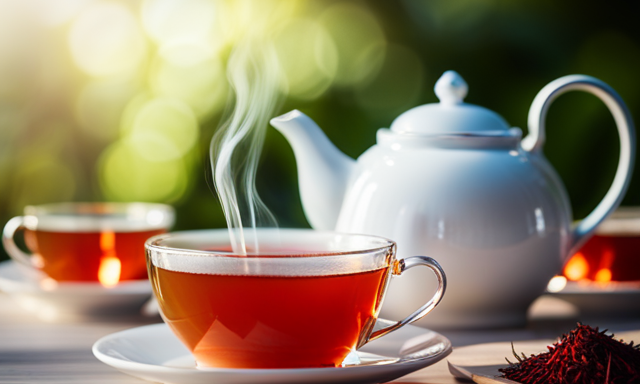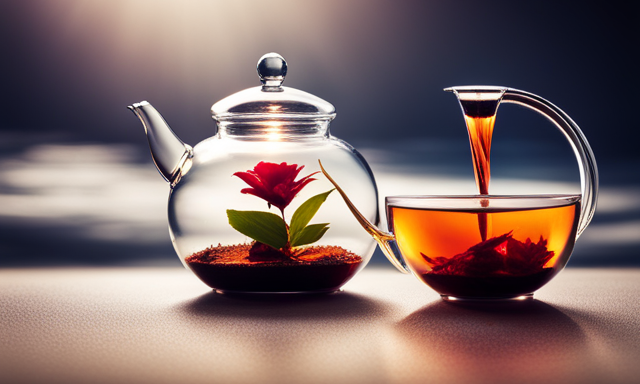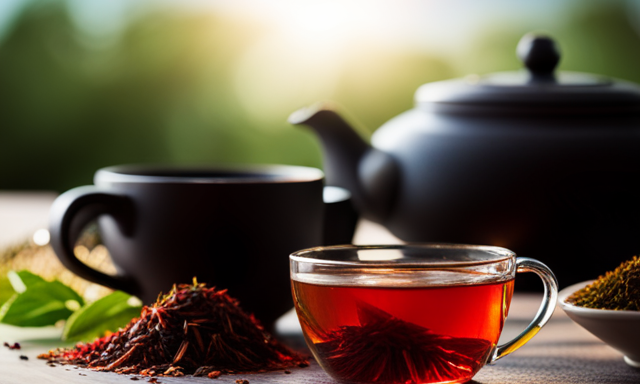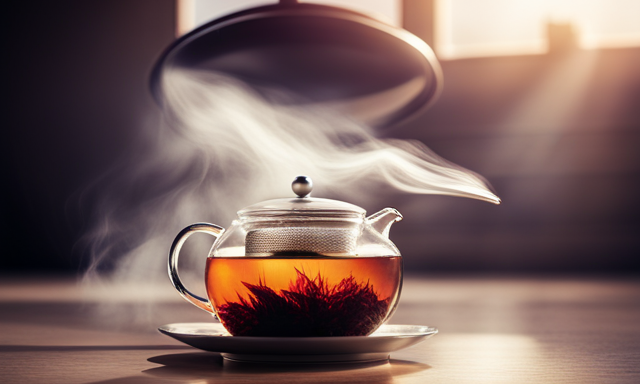Have you ever taken a sip of a warm cup of tea and felt an instant sense of calm and relaxation wash over you? That’s the power of rooibos tea.
As a tea enthusiast, I have always found solace in a steaming mug of this South African treasure. The rich and earthy flavors, coupled with its numerous health benefits, make rooibos tea a true elixir for the mind, body, and soul.
But how long should you brew rooibos tea to achieve that perfect balance of flavor and aroma? That’s the question I aim to answer in this article. Through my research and personal experience, I will guide you on the journey of understanding the art of brewing rooibos tea. From choosing the right leaves to exploring different brewing methods, we will explore every aspect of this delightful beverage.
So, grab your favorite teapot and let’s embark on a tea-sipping adventure together, unraveling the secrets of rooibos tea one cup at a time.
Key Takeaways
- Rooibos tea requires a longer steeping time compared to traditional teas.
- The recommended brewing time for rooibos tea is 5-7 minutes.
- It is important to use boiling water when brewing rooibos tea.
- High-quality organic rooibos leaves from the Cederberg region in South Africa should be purchased from reputable vendors for authenticity.
Understanding Rooibos Tea
Imagine yourself sipping on a warm, soothing cup of rooibos tea, as you discover the unique flavors and benefits of this South African herbal infusion.
Rooibos tea, also known as red bush tea, is renowned for its numerous health benefits. Packed with antioxidants, it helps boost the immune system, improve digestion, and reduce inflammation. This caffeine-free beverage is also rich in minerals like calcium, magnesium, and potassium, which are essential for maintaining healthy bones and muscles.
When it comes to brewing techniques, rooibos tea requires a slightly longer steeping time compared to traditional teas. For the best results, use boiling water and steep for about 5-7 minutes. This allows the flavors to fully develop, resulting in a rich and vibrant cup of tea.
Now, let’s move on to choosing the right rooibos tea leaves…
Choosing the Right Rooibos Tea Leaves
Contrary to popular belief, selecting the perfect rooibos leaves can have a significant impact on the overall flavor experience, leaving tea enthusiasts pleasantly surprised. When it comes to rooibos tea, it’s important to choose leaves that are vibrant and full-bodied. Here are three crucial factors to consider:
-
Quality: Opt for organic rooibos tea leaves to ensure maximum flavor and health benefits. Organic leaves are grown without the use of harmful pesticides or chemicals, resulting in a pure and natural taste.
-
Origin: Look for rooibos tea leaves sourced from South Africa, specifically the Cederberg region. This area’s unique climate and soil conditions produce superior quality leaves, renowned for their rich, sweet taste.
-
Authenticity: Purchase your rooibos tea from reputable vendors to guarantee authenticity. Trusted online retailers and specialty tea shops are great places to find high-quality rooibos leaves.
By selecting the best rooibos tea leaves, you can fully enjoy the numerous benefits this herbal infusion offers. Once you have your leaves, it’s time to move on to preparing your delicious cup of rooibos tea.
Preparing Your Rooibos Tea
When preparing my Rooibos tea, I always make sure to use boiling water that’s around 200°F to 212°F. This temperature range is ideal for extracting the full flavor and benefits of the tea leaves.
Additionally, I steep my Rooibos tea for about 5 to 7 minutes to achieve the perfect balance of flavor without any bitterness.
Boiling water temperature
To achieve the perfect cup of rooibos tea, start by bringing the water to a gentle boil. The boiling water temperature is crucial in extracting the full flavor and health benefits of the rooibos leaves. Maintaining a water temperature of around 203°F (95°C) is ideal for this process. Too high of a temperature can result in a bitter taste, while too low of a temperature may not fully release the flavors.
To help you achieve the right water temperature for your rooibos tea, I have provided a table below with different water temperatures and their corresponding descriptions:
| Water Temperature | Description |
|---|---|
| 185°F (85°C) | Cooler than lukewarm |
| 203°F (95°C) | Gentle boil |
| 212°F (100°C) | Rapid boil |
By using the appropriate water temperature, you can ensure a perfectly brewed cup of rooibos tea. Now let’s move on to the next section and explore the optimal steeping time for the best flavor.
Steeping time for optimal flavor
Let’s dive into the perfect timing to unlock the full flavor explosion of your cup of rooibos tea! When it comes to steeping time for optimal flavor, it’s important to follow the brewing techniques to ensure you get the most out of your tea leaves.
For rooibos tea, the ideal steeping time is around 5 to 7 minutes. This allows the leaves to release their rich and earthy flavors, resulting in a delicious cup of tea. Not only does the right steeping time enhance the taste, but it also maximizes the health benefits of rooibos tea.
Rooibos is known for its antioxidant properties and its ability to boost the immune system. So, by steeping it for the recommended time, you can fully enjoy its goodness.
Now, let’s explore how to enhance the flavor of rooibos tea without compromising its health benefits.
Enhancing the Flavor of Rooibos Tea
Imagine yourself on a journey to unlock the hidden depths of flavor in your rooibos tea, discovering the delightful secrets that lie within. When it comes to enhancing the flavor of rooibos tea, infusing flavors and experimenting with additives can take your tea experience to a whole new level. By adding ingredients like citrus zest, vanilla, cinnamon, or honey, you can create a symphony of taste that complements the natural sweetness of rooibos. To help you get started, here’s a handy table with some flavor combinations to try:
| Additive | Flavor Combination |
|---|---|
| Citrus zest | Rooibos + lemon |
| Vanilla | Rooibos + vanilla |
| Cinnamon | Rooibos + cinnamon |
| Honey | Rooibos + honey |
| Mint | Rooibos + mint |
By experimenting with these additives, you can uncover a whole new world of flavors in your rooibos tea. Now, let’s explore different brewing methods to further enhance your tea experience.
Exploring Different Brewing Methods
When it comes to brewing Rooibos tea, there are two main methods that I’ve found to be particularly effective: traditional hot brewing and cold brewing for iced tea.
Traditional hot brewing involves steeping the tea leaves in hot water for a certain amount of time to extract the flavors and aromas.
On the other hand, cold brewing is a method where the tea leaves are steeped in cold water for a longer period of time, resulting in a smoother and less bitter taste.
Both methods have their own unique advantages and can be used to create refreshing and delicious cups of Rooibos tea.
Traditional hot brewing
Brewing rooibos tea the traditional way creates a comforting aroma and a rich flavor that warms the soul. When it comes to understanding rooibos benefits, this method brings out the tea’s full potential. The hot water extracts the goodness from the leaves, allowing you to enjoy the health benefits of rooibos tea.
To make traditional rooibos tea, simply follow these steps:
| Step | Ingredients | Instructions |
|---|---|---|
| 1 | Rooibos tea leaves | Boil water in a kettle. |
| 2 | Hot water | Rinse your teapot with hot water to warm it up. |
| 3 | Teapot | Add 1 teaspoon of rooibos tea leaves per cup of water to the teapot. |
| 4 | Timer | Pour the hot water over the leaves and let it steep for 5-7 minutes. |
| 5 | Strainer | Strain the tea into your cup and enjoy! |
Now, let’s explore another brewing method: cold brewing for iced tea.
Cold brewing for iced tea
Chill out and create a refreshing rooibos iced tea with the cool and convenient cold brewing method. Cold brewing offers a unique set of benefits when it comes to preparing rooibos tea. By steeping the tea leaves in cold water for an extended period of time, you can extract a smoother, sweeter flavor profile without the bitterness that can sometimes come with hot brewing. This method also preserves the tea’s antioxidants and other beneficial compounds, making it a healthier choice.
When choosing the best rooibos tea brands for cold brewing, look for those that offer high-quality, organic leaves. These brands often provide a more robust and flavorful tea.
Now that you’ve learned about cold brewing, let’s explore how to store and preserve your delicious rooibos tea.
Storing and Preserving Rooibos Tea
To keep your rooibos tea fresh and flavorful, make sure to store it in an airtight container. Proper storage is essential for preserving the taste and quality of your tea. Here are four key tips to ensure your rooibos tea stays in its prime:
-
Keep it away from light: Rooibos tea is sensitive to light, which can cause it to lose flavor and nutrients. Store it in a dark cupboard or pantry to protect it from harmful UV rays.
-
Avoid moisture: Moisture can lead to mold or spoilage. Make sure your container is completely dry before storing your tea and keep it away from humid areas.
-
Stay cool: Heat can also compromise the flavor of your rooibos tea. Choose a cool and dry spot to maintain its freshness.
-
Check the shelf life: Like any other food or beverage, rooibos tea has a shelf life. While it can last for up to two years when stored properly, it’s best to consume it within a year for optimal taste.
By following these storage guidelines, you can enjoy a consistently delicious cup of rooibos tea. Now, let’s explore how to pair this delightful brew with your favorite foods.
Pairing Rooibos Tea with Food
Indulging in a warm cup of rooibos tea and savoring its rich flavors, I can’t help but imagine the perfect pairing with a slice of velvety chocolate cake. The natural sweetness and earthy undertones of rooibos tea make it an ideal choice to complement a variety of desserts. Whether it’s a decadent chocolate mousse or a delicate fruit tart, rooibos tea adds a depth of flavor that enhances the overall dining experience.
To make it easier for you to choose the perfect dessert to accompany your rooibos tea, here is a handy table that pairs different types of desserts with specific rooibos tea flavors:
| Rooibos Tea Flavor | Recommended Dessert |
|---|---|
| Vanilla Rooibos | Crème Brûlée |
| Honeybush Rooibos | Apple Pie |
| Chai Rooibos | Pumpkin Spice Cake |
| Berry Rooibos | Mixed Berry Cobbler |
Not only does rooibos tea enhance the taste of desserts, but it also offers numerous health benefits. Packed with antioxidants and anti-inflammatory properties, rooibos tea can support digestion, boost the immune system, and promote overall well-being.
Transitioning into the next section about discovering rooibos tea varieties, let’s explore the wide range of flavors and blends that rooibos tea has to offer.
Discovering Rooibos Tea Varieties
When it comes to rooibos tea, there are two main varieties to explore: green rooibos and red rooibos. Green rooibos is unfermented and has a lighter, more delicate flavor profile, while red rooibos is fermented and has a richer, earthier taste.
Additionally, there are rare and specialty blends of rooibos tea that incorporate unique ingredients and flavors, offering a truly distinctive and memorable tea experience.
Green rooibos vs. red rooibos
Did you know that the health benefits of green rooibos tea are as abundant as the vibrant green color it possesses? Green rooibos is less processed than its red counterpart, which means it retains more of its natural antioxidants and nutrients.
Here are some of the benefits of green rooibos tea:
-
Boosts the immune system: Green rooibos tea is rich in antioxidants, which help strengthen the immune system and protect against common illnesses.
-
Supports heart health: Studies have shown that green rooibos tea can help lower blood pressure and reduce the risk of heart disease.
-
Promotes skin health: The antioxidants in green rooibos tea have anti-aging properties and can help improve skin elasticity and reduce the appearance of wrinkles.
Now, let’s explore the world of rare and specialty rooibos blends.
Rare and specialty rooibos blends
Immerse yourself in the world of unique and distinctive blends, where rare flavors and specialty ingredients are carefully combined to create exquisite infusions that will transport your taste buds to new heights. When it comes to rooibos tea, there is a wide array of rare rooibos blends and specialty rooibos flavors that cater to the adventurous tea connoisseur. These blends go beyond the traditional red rooibos and offer a delightful twist to your tea experience. From fruity infusions like mango rooibos to floral blends like rose rooibos, there is something to suit every palate. To give you a taste of the variety, here is a table showcasing some of the most sought-after rare and specialty rooibos blends:
| Blend Name | Flavor Profile | Ingredients |
|---|---|---|
| Mango Rooibos | Fruity and tropical | Rooibos, mango, hibiscus |
| Rose Rooibos | Floral and fragrant | Rooibos, rose petals |
| Chai Rooibos | Spicy and aromatic | Rooibos, cinnamon, ginger |
| Mint Rooibos | Refreshing and invigorating | Rooibos, peppermint |
| Vanilla Rooibos | Sweet and creamy | Rooibos, vanilla bean |
These rare rooibos blends and specialty flavors elevate the tea-drinking experience by adding complexity and depth to each cup. Now, let’s delve into the history and cultural significance of rooibos tea, where we’ll uncover its origins and its role in South African traditions.
The History and Cultural Significance of Rooibos Tea
The history and cultural significance of Rooibos tea is a fascinating topic that highlights the indigenous origins and traditions of this unique beverage. It has been enjoyed for centuries by the indigenous people of South Africa, who’ve long recognized its numerous health benefits.
In modern South African culture, Rooibos tea has become an integral part of daily life, with its popularity extending beyond the country’s borders.
Indigenous origins and traditions
You’ll be intrigued to know that rooibos tea has a rich history rooted in indigenous origins and traditions, with over 300 years of cultural significance. Indigenous practices and customs in South Africa have long recognized the medicinal benefits of rooibos tea, using it for various ailments and as a general wellness tonic. This herbal infusion is made from the leaves of the Aspalathus linearis plant, which is native to the Cederberg region. The knowledge of how to prepare and brew rooibos tea has been passed down through generations, with specific techniques and rituals associated with its cultivation and consumption. To give you a visual representation, here’s a table showcasing the indigenous origins and traditions of rooibos tea:
| Indigenous Origins | Medicinal Benefits | Cultural Significance |
|---|---|---|
| Cederberg region | Aids digestion | Integral part of |
| Relieves stress | South African | |
| Promotes sleep | heritage |
Rooibos tea in modern South African culture continues to hold a prominent place, as it is deeply ingrained in the daily lives and celebrations of the people.
Rooibos tea in modern South African culture
Discover how this aromatic and flavorful beverage has become an integral part of everyday life and festive occasions in modern South African culture.
-
Modern tea ceremonies: Rooibos tea is often served in modern tea ceremonies, where it takes center stage alongside other traditional South African dishes. These ceremonies provide a platform for showcasing the rich cultural heritage of the country and are a way of honoring the past while embracing the present.
-
Health benefits of rooibos tea: In addition to its delicious taste, rooibos tea is also known for its numerous health benefits. It’s rich in antioxidants, which help to boost the immune system and protect against free radicals. It’s also caffeine-free, making it a great alternative to traditional tea and coffee.
-
Festive occasions: Rooibos tea is a staple at festive occasions such as weddings, birthdays, and holidays. It’s often served hot or cold and can be enjoyed on its own or with added flavors such as lemon or honey. Its versatility and refreshing taste make it a favorite among South Africans during these special celebrations.
As we dive deeper into the world of rooibos tea, let’s explore some frequently asked questions about this beloved beverage.
Frequently Asked Questions about Rooibos Tea
Get ready to have all your burning questions about Rooibos tea answered! Rooibos tea isn’t just delicious, but it also offers a range of common health benefits. It’s known for its high levels of antioxidants, which can help boost the immune system and protect against free radicals. Additionally, Rooibos tea is caffeine-free, making it a great alternative for those looking to reduce their caffeine intake.
When it comes to brewing techniques, Rooibos tea is quite versatile. It can be brewed hot or cold, depending on your preference. For a hot brew, simply steep the tea bag in boiling water for about 5-7 minutes. If you prefer a cold brew, you can steep the tea bag in cold water and let it sit in the fridge overnight.
In conclusion, Rooibos tea isn’t just a tasty beverage, but it also offers numerous health benefits. Whether you prefer it hot or cold, it’s a refreshing and nutritious choice.
Frequently Asked Questions
Can rooibos tea be consumed by pregnant women?
Rooibos tea can be consumed by pregnant women as it is caffeine-free and rich in antioxidants. It is believed to have potential benefits during pregnancy and does not affect breast milk production.
Does rooibos tea contain caffeine?
Rooibos tea does not contain caffeine, making it a great alternative to other types of tea. It offers numerous health benefits such as improved digestion, reduced inflammation, and enhanced heart health.
What is the recommended daily intake of rooibos tea?
The recommended daily intake of rooibos tea varies, but it’s generally safe to consume 2-3 cups. This delightful beverage offers numerous health benefits, and the brewing methods can be adjusted to suit individual preferences.
Can rooibos tea help with weight loss?
Rooibos tea has potential health benefits, but there is no direct evidence linking it to weight loss. To incorporate it into a weight loss diet, swap sugary drinks for rooibos tea and enjoy it as a low-calorie beverage.
Are there any known side effects of consuming rooibos tea?
There are no known side effects of consuming rooibos tea. In fact, it offers numerous benefits such as promoting digestion, boosting the immune system, and providing antioxidants.
Conclusion
In conclusion, I must say that diving into the world of Rooibos tea has been quite an adventure. From understanding the origins and cultural significance of this delightful beverage to exploring different brewing methods and enhancing its flavor, there’s so much to learn and appreciate.
Whether you’re a tea connoisseur or just someone looking for a new and exciting drink, I highly recommend giving Rooibos tea a try. You won’t be disappointed!
So grab your favorite mug, steep some Rooibos leaves, and let the flavors transport you to a world of pure tea bliss. Cheers, my friends!










